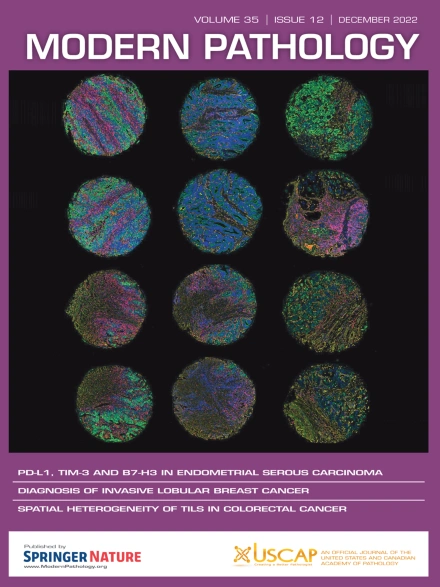Nosologic Reappraisal of the Recently Proposed Calcified Chondroid Mesenchymal Neoplasm Concept in a Series of 20 Cases
IF 5.5
1区 医学
Q1 PATHOLOGY
引用次数: 0
Abstract
“Calcified chondroid mesenchymal neoplasm (CCMN)” is a recently proposed term for tumors with hypercellular chondroid histology and fusion genes. However, its impact on the present classification framework has not been extensively investigated. In this study, we analyzed 20 tumors with histology that would fit with that reported as “CCMN.” With the combined use of RNA sequencing and fluorescence in situ hybridization, 15 tumors were found to have gene fusions, including FN1::FGFR2 (n = 4), FN1::TEK (n = 1), FN1::MERTK (n = 1), PDGFRA::USP8 (n = 2), FN1 rearrangements with undetermined non-FGFR2 partners (n = 4), and PDGFRA rearrangements with undetermined partners (n = 3). FN1 or PDGFRA rearrangement signals were restricted to epithelioid/polygonal cells, indicating that these were neoplastic elements mixed with abundant reactive cells. The fusion-positive tumors were found in 7 men and 8 women aged 29 to 82 years (median, 57 years), and most involved the temporomandibular joints or digits. Tumors showed a chondroid matrix with grungy calcification and cellular components with epithelioid/polygonal cells and were divided into 2 groups the histology of which corresponded to chondroid tenosynovial giant cell tumor or soft-tissue chondroma. Three fusion-positive tumors harbored calcium pyrophosphate dihydrate crystals. Nuclear atypia was frequent. Gene fusions were not detected in the remaining 5 tumors with abundant crystal/calcium deposition, and some may represent reactive conditions. All 20 tumors followed an indolent clinical course, and 4 patients with temporomandibular joint tumors were successfully followed up without surgery for 9 to 60 months. Using “CCMN” as an entity would entail mixed repercussions in diagnostic practice, and how and whether it should be used in diagnosis requires deliberate discussion. The concept may bring some benefits, but it may arguably cause more confusion because it would substantially restructure the conventional framework by drawing a boundary within the chondroma and conflating the chondroma with chondroid tenosynovial giant cell tumor.
最近提出的钙化软骨样间充质肿瘤概念在一系列20例中的病理性重新评估。
钙化软骨样间充质肿瘤(CCMN)是最近提出的一个术语,用于描述具有高细胞软骨样组织学和融合基因的肿瘤。然而,其对现行分类框架的影响尚未得到广泛调查。在这项研究中,我们分析了20个组织学上符合“CCMN”报告的肿瘤。结合RNA测序和荧光原位杂交技术,共发现15例肿瘤存在基因融合,包括FN1::FGFR2 (N=4)、FN1::TEK (N=1)、FN1::MERTK (N=1)、PDGFRA::USP8 (N=2)、FN1与未确定的非FGFR2伴体重排(N=4)和PDGFRA与未确定的伴体重排(N=3)。FN1或PDGFRA重排信号仅限于上皮样细胞/多角形细胞,表明这些是混合了大量活性细胞的肿瘤因子。融合阳性肿瘤7男8女,年龄29-82岁(中位数57岁),多数累及颞下颌关节(TMJ)或指。肿瘤表现为软骨样基质糜黄钙化,细胞成分为上皮样/多角形细胞,分为2组,组织学对应于软骨样腱鞘巨细胞瘤或软组织软骨瘤。三个融合阳性肿瘤含有焦磷酸钙二水合物晶体。核异型性多见。其余5例晶体/钙沉积丰富的肿瘤未检测到基因融合,其中一些可能是反应性的。所有20例肿瘤临床病程均为无痛,其中4例颞下颌关节肿瘤成功随访9 ~ 60个月。使用“CCMN”作为一个实体将在诊断实践中带来复杂的影响,如何以及是否应该在诊断中使用它需要深思熟虑的讨论。这个概念可能会带来一些好处,但它可能会引起更多的混乱,因为它会通过在软骨瘤内划定边界并将软骨瘤与软骨样腱鞘巨细胞瘤混为一谈,从而从根本上重构传统的框架。
本文章由计算机程序翻译,如有差异,请以英文原文为准。
求助全文
约1分钟内获得全文
求助全文
来源期刊

Modern Pathology
医学-病理学
CiteScore
14.30
自引率
2.70%
发文量
174
审稿时长
18 days
期刊介绍:
Modern Pathology, an international journal under the ownership of The United States & Canadian Academy of Pathology (USCAP), serves as an authoritative platform for publishing top-tier clinical and translational research studies in pathology.
Original manuscripts are the primary focus of Modern Pathology, complemented by impactful editorials, reviews, and practice guidelines covering all facets of precision diagnostics in human pathology. The journal's scope includes advancements in molecular diagnostics and genomic classifications of diseases, breakthroughs in immune-oncology, computational science, applied bioinformatics, and digital pathology.
 求助内容:
求助内容: 应助结果提醒方式:
应助结果提醒方式:


